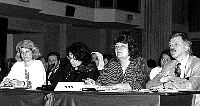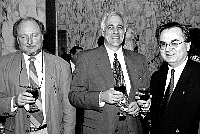| Contents | Previous article | Next article |
![]()
![]()
![]()
| Contents | Previous article | Next article |
![]()
October 1995, vol. 27, no. 10
Effective standards usually function as invisible underpinnings to the work they support and, consequently, we are able to take those standards for granted. Every day, for example, International Standard Book Numbers (ISBN) and International Standard Serial Numbers (ISSN) are used countless times by publishers and booksellers throughout the world to retrieve and exchange commercial information about books. Libraries then catalogue and exchange bibliographic information about those books using the MARC (Machine-Readable Cataloguing) format. The standards that are the basis of the ISBN system and the MARC format were developed and are maintained by people working together under the umbrella of the International Organization for Standardization (ISO) and its Technical Committee (TC) 46. The contributions of those people were very much in evidence when ISO TC 46 gathered in May 1995 for a week of meetings hosted by the National Library of Canada.
ISO Technical Committee 46 is responsible for international standards in the field of information and documentation. It was established in 1947, the same year that ISO itself came into being. Today 29 countries participate actively in TC 46, and 31 other countries have observer status.
ISO members are the national standards organizations for their respective countries. The official Canadian member of ISO is the Standards Council of Canada. Canadian participation in ISO Technical Committee 46, however, is coordinated by the National Library of Canada on behalf of the Standards Council and in consultation with a Canadian Advisory Committee for ISO TC 46.
The work of TC 46 is allocated by subject among six subcommittees and their various working groups. SC 2 covers standards for the transliteration and Romanization of scripts into the Latin alphabet; SC 3 defines the terminology of documentation; SC 4 deals with computer applications for libraries and documentation; SC 8 covers library and publishing statistics; SC 9 develops standards for the presentation, identification and description of documents; and SC 10 works on standards for preservation and document storage. (The apparent oddities of the subcommittee numbering system are explained by the reorganization of subcommittees' work when TC 46 was reconstructed in 1987.) As well as coordinating Canadian participation in these subcommittees, the National Library of Canada provides the International Secretariat for TC 46 Subcommittee 9.
The TC 46 meeting week in Ottawa was attended by about 100 delegates representing 23 countries and several international organizations. The highlights of the subcommittee meetings are given below:
SC 3 met to continue its work on revising and restructuring the ISO vocabulary standard for information and documentation terms.

Canadian delegates at plenary meeting, left to right:
Margaret Stewart, Jan Michaels, Jane Thacker, Ralph Manning..
A joint working group of SC 4 and the ISO Technical Committee for terminology met to review the draft ISO standard for a three-character language code. Compatibility between the ISO language codes and the language codes used in North America will greatly facilitate the international exchange of bibliographic records. There was considerable progress in aligning the ISO language codes with the language codes used in USMARC and CANMARC records. A revised draft will be circulated for voting by ISO members later this year. It was agreed that when this standard is published, the Library of Congress will coordinate and register any future additions to the ISO language code list.
SC 8 met to discuss the ballot results on a draft standard for "Library Performance Indicators". Following a review of the ballots and accompanying comments, the subcommittee agreed that additional work is needed to incorporate comments received and to develop specific performance indicators. It is anticipated that a revised draft will be forwarded late this year for another round of voting.
SC 9 discussed a revision of the ISO standard on the presentation of periodicals to incorporate new specifications for serials in electronic formats. Participants also considered a proposal to merge the ISBN and ISMN (International Standard Music Number) standards in response to concerns raised by the European Article Numbering (EAN) association. Since there was little enthusiasm for this suggestion, the proposal was set aside pending further discussions with EAN representatives. The meeting also reviewed changes to the draft standard on bibliographic references to electronic documents, which is probably the most challenging item in SC 9's current program of work. The draft standard is at the final voting stage, which will end in December 1995. If approved, the standard should be published early in 1996.
SC 9 and SC 4 also held their first joint meeting in recognition of an increasing overlap in their areas of work, a result of the fact that aspects of document presentation and identification are also becoming functions of computer applications. Peter Deutsch of Bunyip Information Systems Inc. spoke to participants about the Internet standards process and the development of Uniform Resource Identifiers for networked information resources.
SC 10 reviewed comments received on many work items, including the draft standard for "Requirements for Hard-Cover and Soft-Cover Books -- Binding Materials and Manufacturing Methods" and "Archival Papers -- Requirements for Permanence and Durability". SC 10 considered a proposal to revise the international standard for permanent paper (ISO 9706) but decided to delay the revision pending the results of research on the effect of lignin content on the ageing of paper being sponsored by several federal government departments, including the National Library, and undertaken by Paprican and the Canadian Conservation Institute in Canada and by the American Society for Testing and Materials. In addition, the subcommittee decided to create a new working group for a standard on requirements for storing and handling sound media and electronic optical media works.

Left to right: Poul Steen Larsen, Convener, Preservation Working Group;
Ivar Hoel, Secretary, Preservation Subcommittee;
Rolf Dahlo, chair, Preservation Subcommittee..
The week of meetings culminated in the biennial plenary meeting of TC 46, which reviewed progress and dealt with procedural issues.
How are ISO standards developed? Each international standard originates in the need to harmonize the practices of several countries to accomplish some common purpose. Proposals for new standards can come from the national committees that mirror each ISO subject committee or from other international organizations that work with ISO. Often, the ISO standard develops from a proposal to adapt a national standard for international use. Each proposal for a new standard is voted on by the member bodies and, if approved, is assigned to a project leader from one of the member bodies or liaison organizations. The project leaders, working with experts nominated by the committee's membership, produce the first and subsequent drafts of the standard for comment and voting by the member bodies. Most draft ISO standards go through at least two rounds of voting during their development. This can be a very time-consuming process, but because the adoption of ISO standards is voluntary, it is extremely important to achieve consensus on these standards while they are under development.
In the case of TC 46 the aim of its standardization activities is usually the international exchange and accessibility of information, as is reflected in its standards for document numbering systems, transliteration, bibliographic references and thesauri as well as the OSI protocols for interlibrary loan applications. Other TC 46 standards establish criteria to support preservation or administration activities. Most of the standards developed by TC 46 are used in libraries and related institutions, but its most widely applied standard, Codes for the Representation of Names of Countries, is probably not recognized as a documentation standard by the majority of its users. This standard, originally developed for bibliographic applications, has since been adopted internationally for shipping, passports, and numerous commercial transactions.
The terms "information age" and "global village" are often used to describe trends in communications and society. Yet if information is to be truly global, it will depend in part on the development of common international standards that permit information to be stored, accessed and exchanged around the world. This is essentially the same mandate that was given to TC 46 in 1947; what has changed since then is the means by which information is recorded and distributed: it now ranges from paper to multimedia and the Internet. This revolution in the tools for creating and accessing information affects all aspects of the documentation community. For standards bodies it means finding the right balance between standardization and innovation. As ISO's member countries adapt to the changing technological environment, new standards must be developed, and many existing standards will have to be changed. TC 46's continuing role in this process is to work towards a level of harmonization among its member countries that will support the international exchange and accessibility of information.
For further information about Canadian participation in ISO Technical Committee 46, contact:
Margaret Stewart
In Canada, ISO standards are available from the Standards Council of Canada. Contact:
Information and Sales